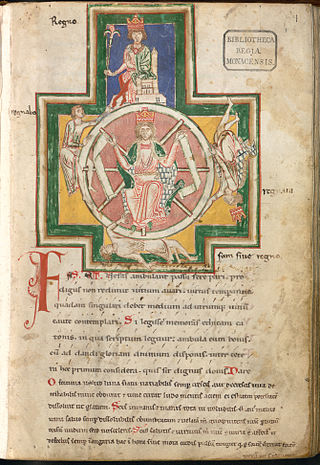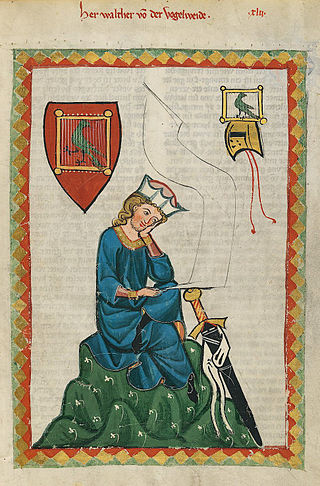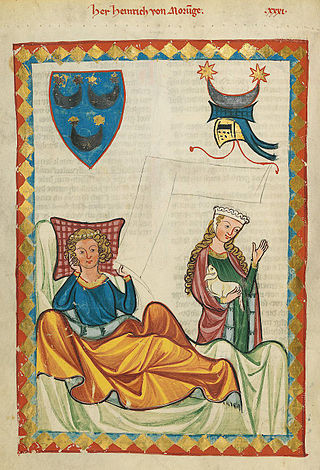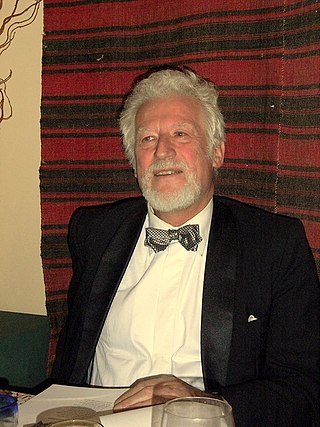
Dietmar von Aist (c. 1115 – c. 1171) was a Minnesinger from a baronial family in the Duchy of Austria, whose work is representative of the lyric poetry in the Danube region.
Contents


Dietmar von Aist (c. 1115 – c. 1171) was a Minnesinger from a baronial family in the Duchy of Austria, whose work is representative of the lyric poetry in the Danube region.

One Dietmar von Aist is mentioned by name from about 1139 onwards in contemporary records from Salzburg, Regensburg and Vienna. The surname probably refers to the Aist River, a left tributary of the Danube below the confluence with the Enns. Since about 1125 the noble family von Aist is evidenced in the Mühlviertel region (present-day Upper Austria), where today the ruins of the ancestral seat stand on the Aist River.
The Upper Austrian Aistersheim water castle was first mentioned in 1159 together with Freiherr (Baron) Dietmar von Aist, a ministerialis of the Babenberg ruler Henry II of Austria. Whether he is really to be identified with the poet is not completely certain on chronological grounds. A certain Ditmarus de Agasta mentioned in further records, who died childless about 1171, is possibly the same as Dietmar von Aist.
Dietmar is also referred to in the 1220s poem Diu Crône by Heinrich von dem Türlin.
A whole series of songs is ascribed to Dietmar, but his authorship can be clearly decided in only a few cases. With those verses which can be attributed to him without any doubt, he belongs in the earliest period of the Minnesang. Dietmar von Aist and his work represent the link between the uncourtly and the courtly forms.
He was one of the first poets to use the refrain and the Tagelied form Wechsel. The themes of his songs are mostly to do with the relationship of men to women (love, parting, partnership), in which connection some of his poems are written from the female perspective and others from the male. The woman takes a decidedly strong position: for example, she is to be able to choose her own partner freely - cf the poem Ez stuont ein frouwe alleine - There stood a woman alone (eLib Austria; full text in the original). The first surviving Tagelied is also by Dietmar: Slâfest du, friedel ziere? (Are you asleep, dearest one?).

The Codex Manesse is a Liederhandschrift, the single most comprehensive source of Middle High German Minnesang poetry, written and illustrated between c. 1304 when the main part was completed, and c. 1340 with the addenda.

Carmina Burana is a manuscript of 254 poems and dramatic texts mostly from the 11th or 12th century, although some are from the 13th century. The pieces are mostly bawdy, irreverent, and satirical. They were written principally in Medieval Latin, a few in Middle High German and old Arpitan. Some are macaronic, a mixture of Latin and German or French vernacular.

Minnesang was a tradition of German lyric- and song-writing that flourished in the Middle High German period. The name derives from minne, the Middle High German word for love, as that was Minnesang's main subject. People who wrote and performed Minnesang were known as Minnesänger, and a single song was called a Minnelied. The Minnesänger are comparable to the Occitan troubadours and northern French trouvères, but they are "an original German contribution to courtly lyric."

Walther von der Vogelweide was a Minnesänger who composed and performed love-songs and political songs (Sprüche) in Middle High German. Walther has been described as the greatest German lyrical poet before Goethe; his hundred or so love-songs are widely regarded as the pinnacle of Minnesang, the medieval German love lyric, and his innovations breathed new life into the tradition of courtly love. He was also the first political poet to write in German, with a considerable body of encomium, satire, invective, and moralising.

Neidhartc. 1190 – c. 1240 was one of the most famous Minnesänger. With around 1500 documented strophes of his songs surviving, Neidhart has the largest corpus of surviving lyrics of any Minnesänger, suggesting the great popularity of the songs. In addition, and quite unlike any of his contemporaries, many melodies to his songs have been preserved: manuscripts have almost 70 melodies to 55 of his songs.

Heinrich von Morungen was a Minnesinger, whose 35 surviving Middle High German songs are dated on both literary and biographical grounds to around the period 1190–1200. Alongside Walter von der Vogelweide and Reinmar he is regarded as one of the most important Minnesänger: he was "the most colourful, passionate, tender and musical of the Minnesänger" and his work "marks a new and brilliantly effective stage in the development of the German lyric."

Der von Kürenberg or Der Kürenberger was a Middle High German poet and one of the earliest Minnesänger. Fifteen strophes of his songs are preserved in the Codex Manesse and the Budapest Fragment.

The Annolied is an Early Middle High German poem in praise of Archbishop Anno II of Cologne. Anno died in 1075 and the poem, probably written in the years immediately after his death, can be seen as part of a campaign for his canonisation, which was finally achieved in 1183. The modern title is taken from the heading given to it by Martin Opitz in his edition of the text: RHYTHMVS DE S. ANNONE COLONIENSI ARCHIEPISCOPO.

Reinmar von Hagenau was a German Minnesänger of the late twelfth century who composed and performed love-songs in Middle High German. He was regarded by his contemporaries as the greatest Minnesänger before Walther von der Vogelweide, a view widely shared by modern scholars. Although there are uncertainties as to which songs can be reliably attributed to him, a substantial body of his work — over 60 songs — survives. His presentation of courtly love as the unrequited love of a knight for a lady is "the essence of classical Minesang".

Friedrich von Hausen was a medieval German poet, one of the earliest of the Minnesingers; born sometime between 1150–60; d. 6 May 1190.

The Aist is a river in Upper Austria, a left tributary of the Danube. It drains an area of 636 km2 (246 sq mi).
Middle High German literature refers to literature written in German between the middle of the 11th century and the middle of the 14th. In the second half of the 12th century, there was a sudden intensification of activity, leading to a 60-year "golden age" of medieval German literature referred to as the mittelhochdeutsche Blütezeit. This was the period of the blossoming of Minnesang, MHG lyric poetry, initially influenced by the French and Provençal tradition of courtly love song. The same sixty years saw the composition of the most important courtly romances. again drawing on French models such as Chrétien de Troyes, many of them relating Arthurian material. The third literary movement of these years was a new revamping of the heroic tradition, in which the ancient Germanic oral tradition can still be discerned, but tamed and Christianized and adapted for the court.

The lokator was a medieval sub-contractor, who was responsible to a territorial lord or landlord for the clearing, survey and apportionment of land that was to be settled. In addition, he hired settlers for this purpose, provided their means of subsistence during the transitional period and made materiel and implements available, such as seed, draught animals, iron ploughs, etc. He thus played a key role during the establishment of new towns and villages, as well as the clearing of uncultivated land during the phase of internal colonisation (Binnenkolonisation) in North German and the German Ostsiedlung and participated in its success.

The County of Moers was a historical princely territory on the left bank of the Lower Rhine that included the towns of Moers and Krefeld as well as the surrounding villages and regions.

Meinloh von Sevelingen was a 12th-century Minnesänger from Swabia and one of the earliest poets in the tradition.
Wilhelm Franz Josef Kosch was an Austrian historian of literature and theatre and lexicographer. The lexicon that he conceived and later revised several times, the Deutsches Literatur-Lexikon is a references in the field of German literature.

Cyril William Edwards was a British medievalist and translator. Teaching in London and Oxford, he published extensively on the medieval German lyric and Old High German literature, and translated four of the major Middle High German verse narratives.

Helmut Birkhan is an Austrian philologist who is Professor Emeritus of Old High German Language and Literature and the former Managing Director of the Institute for Germanic Studies at the University of Vienna.
Rudolf Kötzschke was a German historian who founded the Seminar for Regional History and Settlement Studies in Leipzig, the first regional history institution at a German university.

Der Marner was a 13th-century itinerant poet and singer in the Middle High German language, whose work is preserved in the Codex Manesse. He was born in Swabia and obviously enjoyed a good school education. He wrote some of his works in the service of the Hohenstaufen dynasty. According to Meister Rumelant, he went blind in old age and was murdered before 1287, probably during the interregnum.